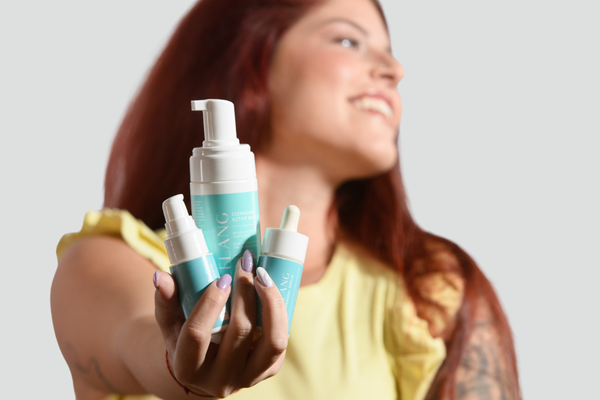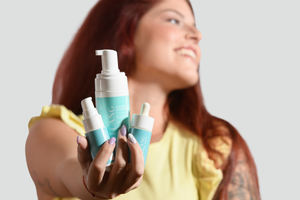TABLE OF CONTENTS
- What tired skin really is and its connection with cortisol
- How to recognize tired skin from stress (and not just “dry” skin)
- High cortisol: the stress hormone that accelerates skin aging
- Hormonal and neurocutaneous skincare: a different approach
- Neurocosmetics, adaptogens, and antioxidants: lowering cortisol with the right actives
- Anti-stress face routine: daily skincare for high cortisol
- Body and mind: anti-stress sensory rituals with LeLang
Dull complexion, darker under-eye circles, more pronounced wrinkles, makeup that doesn't apply as smoothly. If you have noticed these features on your face, you might be suffering from tired skin or be in a phase of high cortisol.
When stress becomes chronic, its effects manifest not only in the mind and body but also on the skin, which loses brightness, appears more marked, and struggles to regenerate. This happens because increased cortisol alters the hormonal and inflammatory balance of the skin.
Nothing unsolvable: a healthier and more relaxed lifestyle helps inner and outer balance. In the meantime, you can opt for a targeted anti-stress skincare with a hormonal or neurocosmetic approach. This routine can lower the "background noise" of stress on the skin and restore tone, comfort, and vitality.
Skincare, when thought of from a cosmeceutical and hormonal perspective, can become a concrete ally to bring the skin back to a balanced state: it's not about "covering" the signs of tiredness, but about acting on the mechanisms that stress triggers, with neurocosmetic actives, adaptogens, soothing and antioxidants.
In this article, we explore what it really means to have tired skin, the role cortisol plays, and how to build an anti-stress routine with the most targeted products from the LeLang world.
What tired skin really is and its connection with cortisol
If your face looks dull, gray, tight, and more marked, or you are experiencing rosacea, irritations, and inflammations, you might be suffering from tired skin. These are the signals your skin sends to defend itself from chronic stress that is disrupting its balance.
A constantly connected life, sleepless nights, work or family worries, altered emotional states, or hormonal fluctuations (related to the cycle, perimenopause, or menopause) affect cortisol production, the well-known stress hormone, which remains constantly elevated. This leads to imbalances that manifest in the body and mind.
The combination of emotional stress, mental load, social FOMO, and intense shifts increases cortisol and changes the skin's response to external stimuli. For this reason, tired skin is often described as “in burnout”: it no longer has the resources to defend and regenerate itself as efficiently as before.
The skin is one of the first organs to show the consequences with:
- Gray complexion.
- Hollowed features.
- More frequent irritations and imperfections.
In cosmeceuticals, tired skin is not just an aesthetic issue but the result of a series of functional imbalances: slowed microcirculation, weakened skin barrier, increased oxidative stress, and altered cell regeneration rhythms. This translates into dull complexion, uneven texture, loss of tone, and more pronounced signs.
How to recognize tired skin from stress (and not just “dry” skin)
The first signs are subtle but recognizable:
- The face looks less “full.”
- The skin appears grayish or yellowish.
- Make-up no longer applies with the same evenness.
- Expression lines become more noticeable.
Tone sags especially in critical areas (eye contour, cheekbones, mouth), creating that look of chronic tiredness even on days when, theoretically, you are rested.
Over time, tired skin may show a greater tendency to dehydrate, redden, or overreact to previously tolerated cosmetics: this is a sign that the barrier is struggling and internal stress is translating into skin fragility. This is often accompanied by darker under-eye circles, puffiness, and a general loss of radiance.
The face becomes a “dashboard” of chronic stress. This is because what changes is precisely the hormonal profile and production of inflammatory mediators. Cortisol remains high for too long and interferes with night repair processes and alters sebum production, making the skin more vulnerable. Intervening with targeted skincare is an essential protection and balance strategy.
High cortisol: the stress hormone that accelerates skin aging
Under normal conditions, cortisol is essential for survival: in acute stress situations, it helps the body react by modulating energy, inflammation, and immune response.
The problem arises when stress becomes chronic. Our skin is a neuroendocrine system that communicates with the systemic one: it not only perceives the presence of cortisol in the body but also produces it in turn, feeding a local stress circuit.
The result is a pro-inflammatory environment, with an increase in free radicals, worsening barrier defenses, and slowing repair processes. Chronically elevated skin cortisol can:
- Reducing collagen and elastin synthesis.
- Slowing down the production of ceramides and other barrier lipids.
- Increasing the production of free radicals.
The skin appears thinner, less elastic, more dehydrated, and prone to irritation and redness. Stress also activates pro-inflammatory mediators such as cytokines.
Hormonal and neurocutaneous skincare: a different approach
The skin is a true hormone-dependent organ. When stress adds to hormonal transition phases (PMS, pregnancy, perimenopause, or menopause), the skin can change rapidly becoming suddenly drier, more reactive, or more impure.
A skincare that follows the “hormonal” or neurocutaneous cycle takes into account how hormones and the cutaneous nervous system influence the skin. The goal is to accompany the skin through different life stages, modulating inflammation, sensitivity, and stress response, rather than “forcing” the skin with aggressive actives.
The concept of neurocutaneous balance arises from recognizing that nerve mediators (such as beta-endorphins) influence comfort, inflammation, vascularization, and radiance. Neurocosmetics aim to modulate this communication, lowering skin cortisol and stimulating “well-being” molecules. In practice, actives capable of lowering local stress signals are used, putting the skin in a condition to perceive less stress.
Neurocosmetics, adaptogens, and antioxidants: lowering cortisol with the right actives
Anti-Stress Neurocosmetics
Neurocosmetics is the frontier of cosmeceuticals studying how topical actives can interact with neurons and receptors in the skin. Among the signature actives is the extract of Tephrosia Purpurea (Neurophroline complex): in vitro studies indicate it can reduce cortisol production in skin cells (by up to about 70%) and stimulate the release of beta-endorphins, the neuropeptides of well-being.
Adaptogens
The adaptogens help the body better adapt to stress. In skincare, this translates into actives that reduce the skin's stress response, improve its resilience, and help it not to overreact or "collapse" at the first stimulus.
Antioxidants
Along with stress, the production of free radicals increases. Topical antioxidants, such as polyphenols and vitamins, are essential to extinguish this "invisible fire." Included in the daily routine, they protect vital skin structures like collagen, elastin, lipids, and cellular DNA, reducing the contribution of oxidative stress to premature aging.
Anti-stress face routine: daily skincare for high cortisol
1. Gentle Cleansing
Everything starts with cleansing. Choose gentle cleansers with mild surfactants to remove impurities and sebum without damaging the skin barrier. Morning and evening, avoid water that is too hot and vigorous rubbing.
Recommended Cleanser

Cleansing Detox Mousse is a detoxifying cleanser formulated with minerals and enzymatic extracts, to cleanse and provide essential minerals for brightness and hydration. It contains Aloe Vera (soothing) and Hydromanil.
Discover Cleansing Detox Mousse2. Serums: Antioxidant (Day) and Regenerating (Night)
After cleansing, move on to the face serum, the product with the highest concentration of active ingredients. In an anti-stress routine, an antioxidant and brightening serum to combat dullness is a must.
Morning: Anti-Pollution Illuminating Serum

Licoglow Serum is the anti-pollution illuminating serum with Hydromanil, Mullein (known for its luminescence), Betaine, and Lycopene, all active ingredients with strong antioxidant and anti-inflammatory properties.
Discover Licoglow SerumEvening: Regenerating Serum

Stressed skin needs regeneration. For this reason, you can use Elyx Performance in the evening, a regenerating serum that repairs tissues, evens out complexion, and reduces loss of tone. Based on Snail Mucin, Hyaluronic Acid, and Rose Oil.
Discover Elyx Performance3. Anti-Fatigue Eye Contour
The periocular area is one of the first to show stress (dark circles, puffiness, heavy eyelids).
Draining and Lifting Eye Contour

A specific eye contour like Formula Eyes Duo Peptide, with draining, illuminating actives and an instant lifting effect, is essential to give the gaze a fresher and more rested look.
Discover Formula Eyes Duo Peptide4. Protective and Rebalancing Face Cream
Complete the routine with a protective and anti-stress face cream. The cream seals in hydration and provides soothing and rebalancing actives.
Anti-Irritation Face Cream

Nutralight Sensitive uses thermal water from the Piedmont Alps, rich in minerals with soothing action, to reduce irritations and redness. Its low lipid content also makes it suitable for combination or acne-prone skin.
Discover Nutralight SensitiveBody and mind: anti-stress sensory rituals with LeLang
Managing skin stress can extend to the whole body. For this reason, LeLang has created a line of body products containing the extract of Tephrosia Purpurea. This active ingredient modulates cortisol production on the skin, turning the daily routine into a therapeutic ritual for skin and mind.
The Relax line includes Shower Gel, Bath Foam (enriched with Avena sativa, sweet almond oil, and aloe vera), Hydrating Body Scrub, and a Massage Oil. The integration of Tephrosia Purpurea, an anti-cortisol active ingredient and beta-endorphin stimulator, offers total well-being visible on the skin.
The oil can be used in an evening ritual, combined with deep breathing, to send a "signal" to the nervous system to slow down.
This is exactly where LeLang Skincare's scientific vocation is expressed: the goal is to create formulations that not only make the skin look beautiful but also respect and support its deep mechanisms, including the dialogue between hormones, the cutaneous nervous system, and the environment.







